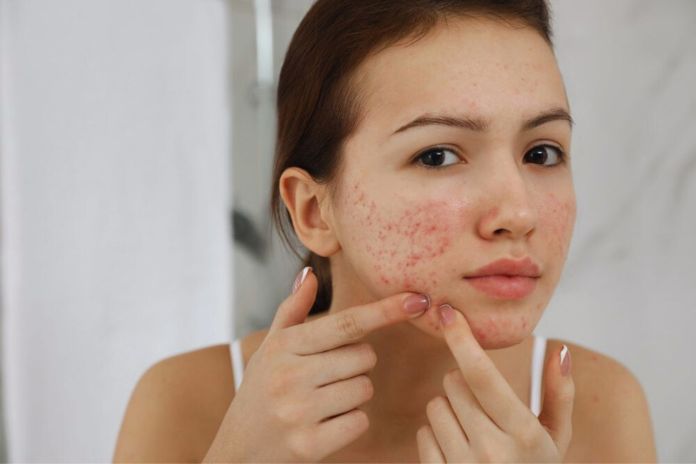Every battle against acne is never fun: once the pimples give up, they sometimes leave behind scars that are sometimes difficult to get rid of. To find out how to fade these marks, here are some professional tips.
Can You Recognize Your Type Of Scar?
If there were only one type of scar, everything would be much simpler, but unfortunately, there are 3, all very different from each other :
Atrophic Scars
Atrophic scars, also called “ice picks,” appear in the form of hollows. They occur when an inflamed wound does not heal properly, there is insufficient connective tissue to recreate a uniform skin surface, or the “dry scab” is torn off before it eventually falls off on its own.
Hypertrophic Scars
Also called Keloids, hypertrophic scars can be recognized by their raised and slightly swollen character. They are usually created when one or more pimples become inflamed, and the skin produces excess new “low-quality” tissue. A phenomenon regularly observed on the darkest skin.
Pigmentary Scars
These are the most common, but fortunately, they are also the ones that go away the quickest and easiest. Red, brown, purple, or pink… They can take on different colors depending on the pigmentation of your skin and appear following the inflammation of a pimple. In this case, melanin production is intensified by the sun’s rays and can accumulate after healing.
This is how it leaves one or more visible spots on the skin. For white scars, the process is different. Formerly pink, purple, or red, they have reached their healing maturity and are now turning white. They, therefore, no longer have pigments and are now very difficult to blend.
How To Get Rid Of An Atrophic Scar?
Focus On Hyaluronic Acid
Hyaluronic acid is one of the most effective treatments for filling the hollow in the area to be treated. As an injection or cream to apply in the evening before bed, this cosmetic ingredient serves the tissues and allows them to enhance in order to give a smooth appearance to the scar.
Go Laser
If hyaluronic acid proves ineffective in filling scars, the best solution to approach remains laser. By heating the skin intensely, this process introduces a new synthesis of collagen which serves the area to be treated. The dermabrasion generated by this technique allows a clear improvement in the entire aesthetic aspect of the scar or even its complete disappearance.
How To Get Rid Of A Hypertrophic Scar?
Hypertrophic scars come from a healing defect and have a very complex recovery process. The reason? This type of scar is generally due to genetics and is, therefore, challenging to treat due to the number of relapses that accompany it. As you will have understood, stimulating healing via slightly offensive techniques will, therefore, not be of any help in overcoming it. The best solution? Try to “stabilize” it by applying silicone dressings and injecting corticosteroids for 3 to 6 weeks.
Radiotherapy
If corticosteroid injections do not help reduce the volume of the scar, it is time to move on to radiotherapy treatment. How? By irradiating the keloid from the inside internally or by intra-scar brachytherapy. A solution that is most often associated with an act of “initial reduction” to weaken the scar.
Could You Not Touch It Too Much?
Since keloids are scars that tend to enlarge, it is best to avoid touching or scratching them too much. The risk? Rubbing fingers or nails can excite collagen production. Result: the scar swells and begins to contaminate “healthy” areas of the skin, but not only that, it can also become inflamed and become painful, and itchy.
How To Get Rid Of A Pigment Scar?
Make Gentle Scrubs
Twice a week, after having adequately removed your make-up, use a gentle scrub to refine the skin’s texture. An excellent way to make the scar less visible but also, above all, to unify the epidermis in order to make it smoother and, therefore, more uniform.
Apply A Depigmenting Treatment
When the scar turns brown, pink, or purple, a depigmenting treatment can be helpful to fade the spots over time by inhibiting the transport of melanin to the upper layers of the skin. Apply morning and evening for best effects.
Use An SPF
Whatever it is, it is essential not to expose a scar to the sun, as this risks making it more visible and making it last over time. For risk-free exposure (or even to go shopping in the city), use a protective sunscreen. Apply it as the last step of your beauty routine, just after your moisturizer. Thanks to it, your scars are protected from the sun and from the inflammatory response of the skin, which will produce brown pigments to protect itself from the rays.
The Last Solution: The Laser!
Sun, unsuitable care… It sometimes happens that pigment scars persist, and it isn’t straightforward to make them disappear. As a last resort, the most suitable solution remains the ablative laser. They make it possible to obtain an improvement of 26 to 83% in patients with hyperpigmented scars. How? Thanks to a deep skin warming process.
Visually, the dermabrasion caused by these lasers allows an improvement in the aesthetic appearance or even their disappearance in the case of the finest and most minor scars. The sessions are carried out, in the majority of cases, after a simple anesthesia with cream delivered in a pharmacy or by the practitioner, to be applied one to two hours before the procedure.
In Short
Because no two scars are alike, it is essential to provide appropriate treatment so that they can gradually fade and leave as few traces as possible. So do not hesitate to consult a dermatologist.
Read Also: Pregnancy Mask: What Treatment And How To Avoid It?

